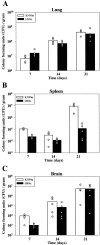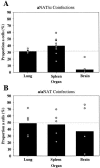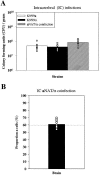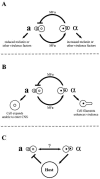Cryptococcus neoformans {alpha} strains preferentially disseminate to the central nervous system during coinfection
- PMID: 16041006
- PMCID: PMC1201212
- DOI: 10.1128/IAI.73.8.4922-4933.2005
Cryptococcus neoformans {alpha} strains preferentially disseminate to the central nervous system during coinfection
Abstract
Cryptococcus neoformans is a fungal pathogen that has evolved over the past 40 million years into three distinct varieties or sibling species (gattii, grubii, and neoformans). Each variety manifests differences in epidemiology and disease, and var. grubii strains are responsible for the vast majority of human disease. In previous studies, alpha strains were more virulent than congenic a strains in var. neoformans, whereas var. grubii congenic a and alpha strains exhibited equivalent levels of virulence. Here the role of mating type in the virulence of var. grubii was further characterized in a panel of model systems. Congenic var. grubii a and alpha strains had equivalent survival rates when cultured with amoebae, nematodes, and macrophages. No difference in virulence was observed between a and alpha congenic strains in multiple inbred-mouse genetic backgrounds, and there was no difference in accumulations in the central nervous system (CNS) late in infection. In contrast, during coinfections, a and alpha strains are equivalent in peripheral tissues but alpha cells have an enhanced predilection to penetrate the CNS. These studies reveal the first virulence difference between congenic a and alpha strains in the most common pathogenic variety and suggest an explanation for the prevalence of alpha strains in clinical isolates.
Figures







References
-
- Aberg, J. A., and W. G. Powderly. 1997. Cryptococcal disease: implications of recent clinical trials on treatment and management. AIDS Clin. Rev. 1997-1998:229-248. - PubMed
-
- Bochner, B. R. 2003. New technologies to assess genotype-phenotype relationships. Nat. Rev. Genet. 4:309-314. - PubMed
-
- Bolaänos, B., and T. G. Mitchell. 1989. Killing of Cryptococcus neoformans by rat alveolar macrophages. J. Med. Vet. Mycol. 27:219-228. - PubMed
Publication types
MeSH terms
Grants and funding
LinkOut - more resources
Full Text Sources
Miscellaneous

